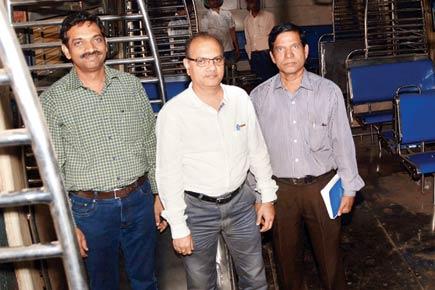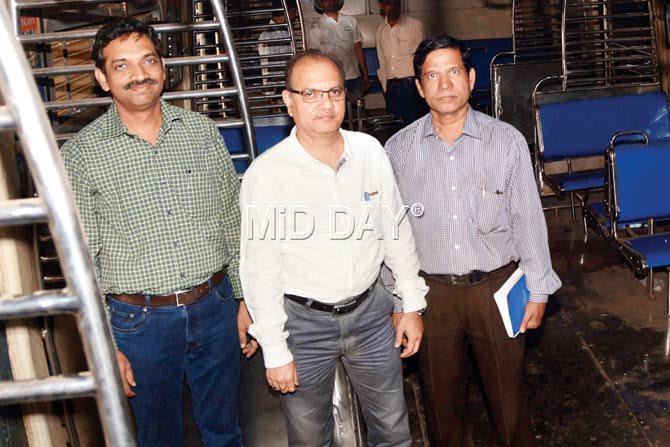SUNDAY mid-day's sneak peek into Central Railway’s work in progress for the new seating arrangements (which turns out to be a lot of standing)

The 101-year-old Matunga Central Railway Workshop — 14 acres inundated with metal, rails, wheels and grease cans — has become a new ground for experiments. The workshop has come up with modified seats for Mumbai's Central Railway (CR) local trains, the first of which will roll out on January 29. Sunday mid-day got an exclusive peek into the making of these new seats, as well as the new seating arrangement, meant for CR’s 42 lakh commuters.

(L-R) Engineers VD Satam, SK Shrivatra and Akshay Pande in the new 2+2 coach at the Matunga Central Railway Workshop. Pic/Sayyed Sameer Abedi
ADVERTISEMENT
The 2+2 seating arrangement was proposed in December last year as a solution to CR’s rush-hour rides. This comes at a time when Union Railway Minister Suresh Prabhu stated on January 22 that the situation of Mumbai’s suburban railways was critical with rising numbers of deaths on tracks.
Blue no more
The engineers from the Matunga workshop are in process of assembling and fitting stainless steel seats for local trains. These seats will replace the blue polycarbonate seats, which were installed about four years ago inside the second-class compartments of CR’s local trains. This is the first time that seats will be made entirely of stainless steel; until now, only the frames were made of steel on which blue cushioned seats (in the first class compartment) or blue/brown polycarbonate seats (in the second class compartment) were placed.
Sources at the workshop said they had got lots of time to think and experiment with the quality of seats. “The polycarbonate seats look better but are brittle. The stainless steel seats are sturdier and will last long,” aid an official from Matunga Workshop. Each new seat costs R4,000, while the polycarbonate ones are Rs 6,000 each.
2+2 seats
On December 22, the CR unveiled the first train with modifications — at a cost of R15 lakh —such as a longitudinal arrangement, removal of seats close to the door and a lessened frame width. That train accommodated 336 people, but this new one will carry an additional 352 people. Officials claim this will not only allow them to accommodate more people but will also not put pressure on the bogie and wheels of the rake which ferries at least 3,600 people every day.
Earlier, the engineers had got merely eight days to work with in order to keep up with the Suburban Accident Committee’s report on tackling railway deaths on the suburban network. In the first rake, they simply removed the seats haphazardly, and cut and welded wherever required. Now, chief workshop manager, Mahesh Kumar, and engineers S Shrivatra, V Satam and A Pande have had time to think of the changes they could experiment with. The new modified rakes cost R30 lakhs — double the previous one — since the modifications are high-end. They fixed 38 steel walls next to the doors, costing R30,000 each, which are now properly trimmed and welded in correct shape, added 40 more handles inside a single coach which normally has 172 handles and also ensured that new seats were tried.
The 2+2 seats was first planned in 1975 by a railway officer named PC Sehgal, who later retired as the Managing Director of Mumbai Railway Vikas Corporation - the planning agency for railways specifically for Mumbai. He was the one who first proposed this type of seating arrangement to accommodate more people.
Longitudinal seating unfeasible
The 2+2 seating arrangement will exist in four coaches, and one of these will also have the longitudinal seating arrangement, as is seen in the metro service. Minor changes will be made inside this coach by placing two steel grab poles — similar to the ones that are present near the door for people to hold — in the middle of the coach.
Sources said that MPs and politicians have demanded the longitudinal seat. However, officials are skeptical, saying that the high number of standing passengers hosted by the longitudinal seating arrangement, will prove heavier for the wheel sets to handle. The Research, Design and Standards Organisation (RDSO) — which is the planning agency for Indian Railways in Lucknow — is studying the feasibility of these longitudinal seats.
 Subscribe today by clicking the link and stay updated with the latest news!" Click here!
Subscribe today by clicking the link and stay updated with the latest news!" Click here!







